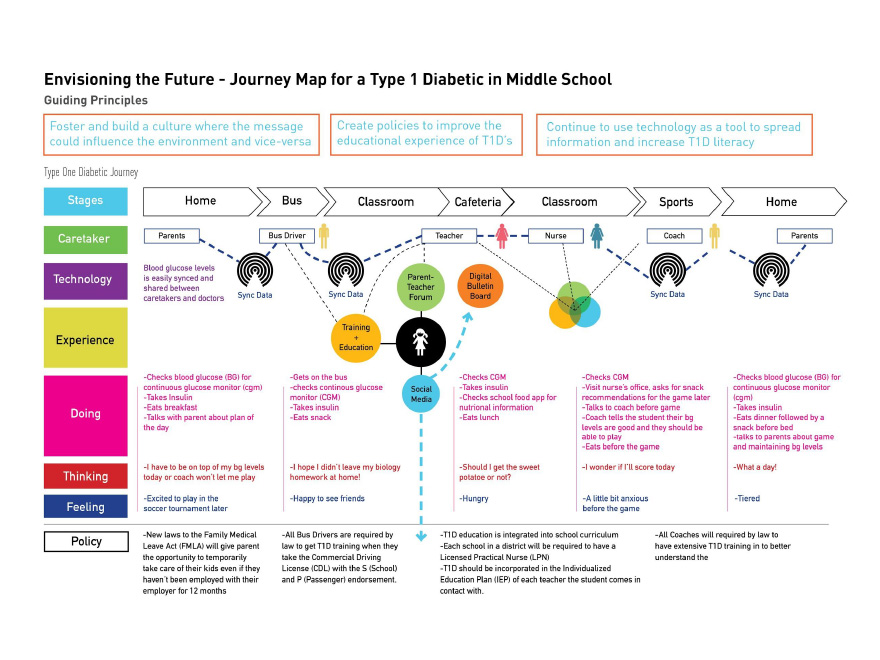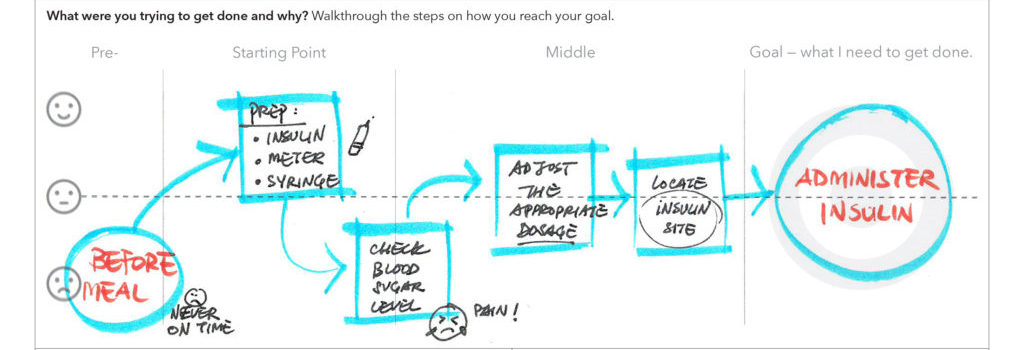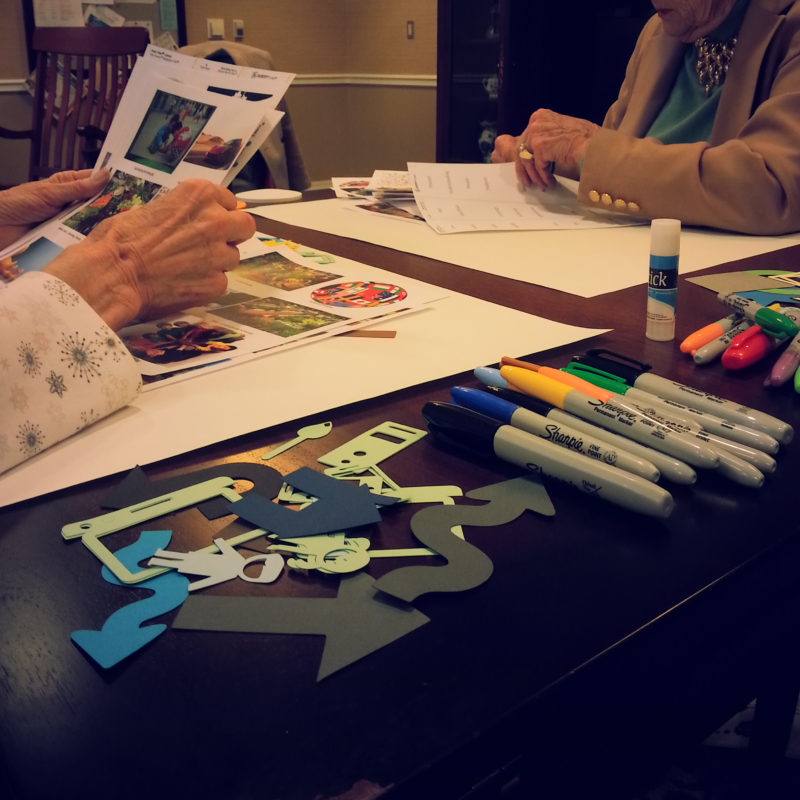TEAM
Darwin / Caroline W / Abel H / Tally W
RESPONSIBILITIES
• Propose research questions + problem statement
• Design research method
• Conduct interviews + co-facilitate in workshops
• Analysis + synthesis
• Develop design principles
BACKGROUND
Type-1 Diabetes (T1D) is a chronic illness that accounts for between 5% and 10% of all diabetes cases. It often is first diagnosed in childhood and it is estimated that about 80,000 children develop the disease each year. In this project, we brought in people living with Type 1 Diabetes and relevant stakeholders to co-design with us.
PART I: EMPATHETIC DESIGN RESEARCH FRAMEWORK
As part of our experience to build empathy and better understand the experience of living with T1D, all members of our group immersed ourselves in either measured blood glucose levels with a meter, wore a continuous glucose monitor, or wore an insulin pump (Medtronic & AccuChek) for about 1 week, which we would then journal throughout the week to document our experiences and the monitoring discrepancies between different products.

While testing the glucose monitoring product was part of the user experience research, the main goal for me was to immerse myself, as much as possible, in a few aspects of living with T1D. There were three aspects that made the biggest impressions on me:
1. Checking blood sugar 10x in a day
It was exhausting a lot of energy (at least when I first started out) both physically and mentally to monitor blood sugar (every day!). Sleeping late and waking up early were part of the routine. Considering our “normal” daily activities, monitoring blood sugar is not another “chore”, it is part of life.
2. Checking blood sugar in public spaces
My immersive experiment only involved checking blood sugar count, not administering insulin (since I was using pump). Even when checking my blood sugar count, gazes from others was unavoidable. While, other people might not make much of it, the emotional insecurities (especially when I first started) was almost always present.
3. Monitoring food intake, especially carb count
It was difficult to eat out, because most restaurants have calorie count, but not carb count. Having Google to help give the carb information was incredibly useful. However, I still need to do the calculation myself for each meal. The other experience I had was being constantly hungry, because trying to control blood sugar level through diet means a very limited amount of carb intake.
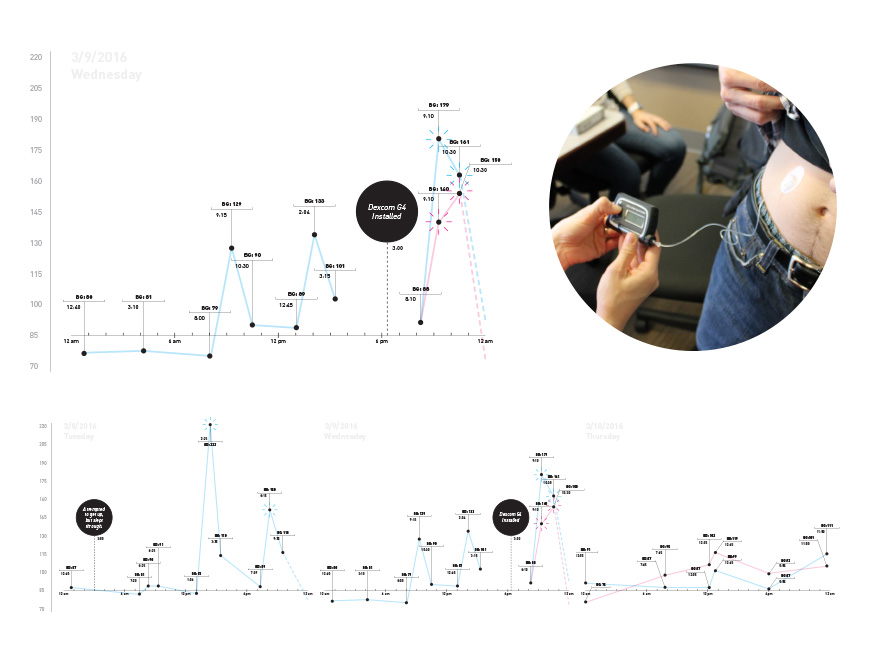
PART II: CO-DESIGN RESEARCH METHOD
The stakeholders for our project include people with Type 1 Diabetes (T1D) and people within the secondary circle of care , which we describe as “the community.” This group includes classmates in school, teachers, coaches, school nurses, coworkers, employers, and the general public. For the first several weeks, we focused on learning about Type 1 Diabetes. We then conducted 3 different types of interviews with stakeholders to better understand the experience of living with T1D and common issues that occur.
PROBLEM STATEMENT
We decided to focus on education about T1D as the primary topic for our final workshop because we realized that a majority of these issues and negative experiences occurred because community members lacked knowledge about T1D.
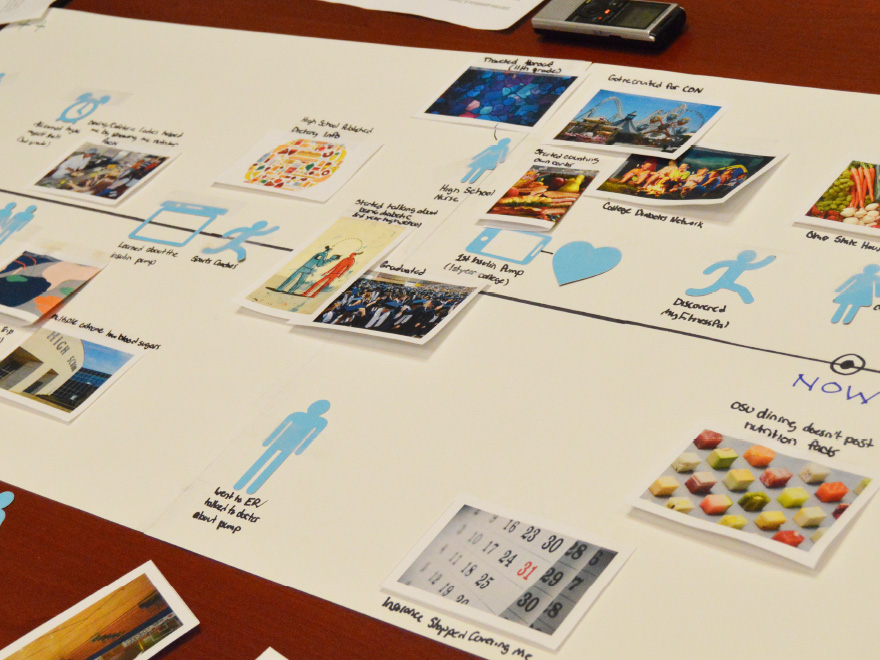
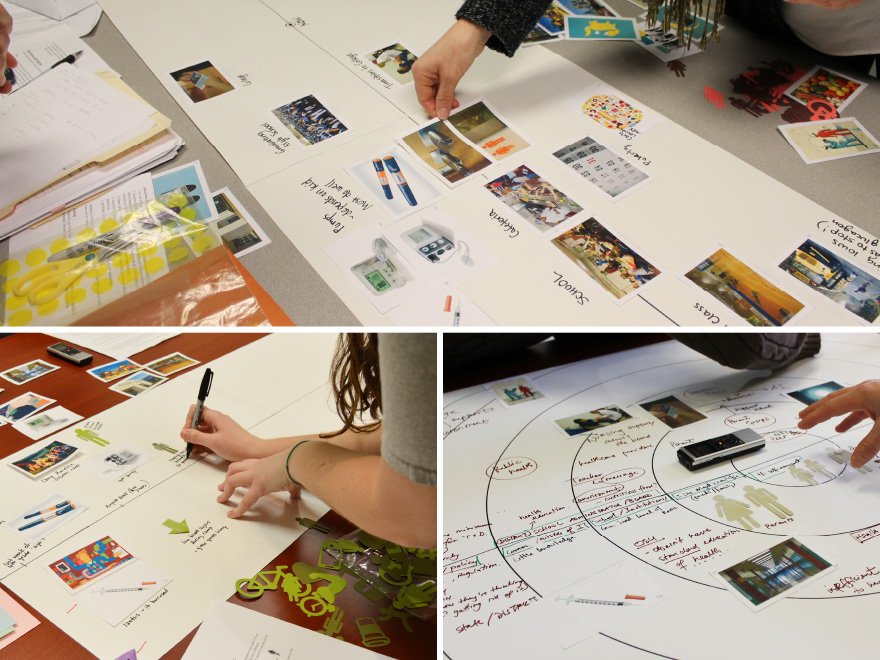
ANALYSIS
Working from a Socioecological framework, we discovered the importance of fostering a culture around T1D. To establish a culture, there are two main components in play: Message and Environment. On the one hand, the function of the message is to create awareness in order to affect the environment that supports T1D. On the other hand, good policies from the environment are necessary to provide a platform and support for the message to be be heard in order to create awareness. It is this paradox that led us to focus on education as the ground to spread both the awareness and policy not only inwards to the individuals and close groups (parents & friends), but also outwards to the state and federal level where cultural awareness would influence policy.
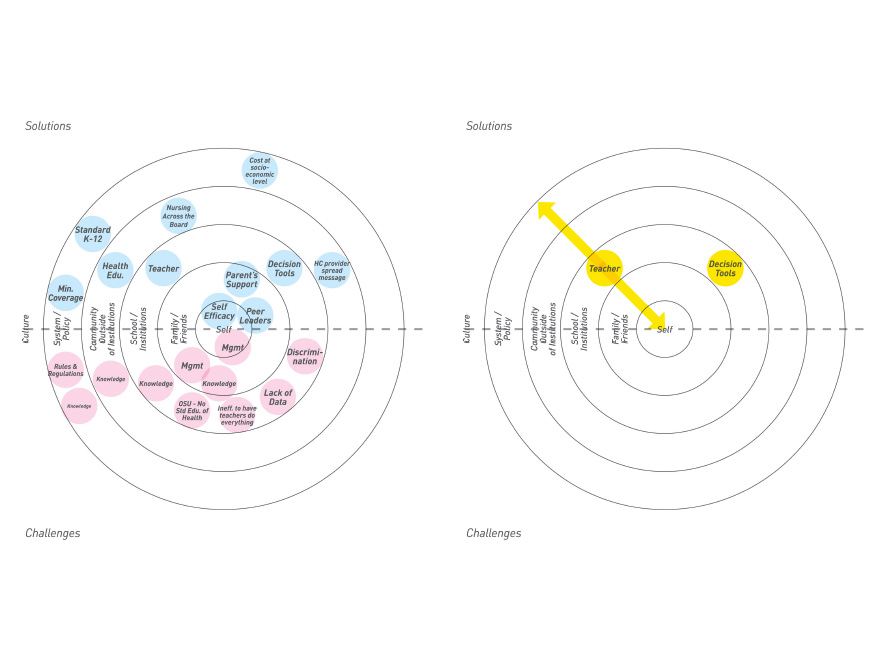
CO-DESIGN
From here, we created 2 activities the first for envisioning the ideal experience for T1D students in a middle school, and the second for creating a strategy for how to implement this vision and spread awareness and knowledge about T1D. We decided on the environment of a middle school because we believed it covered a majority of issues described in elementary and high school as well as transition periods in between.
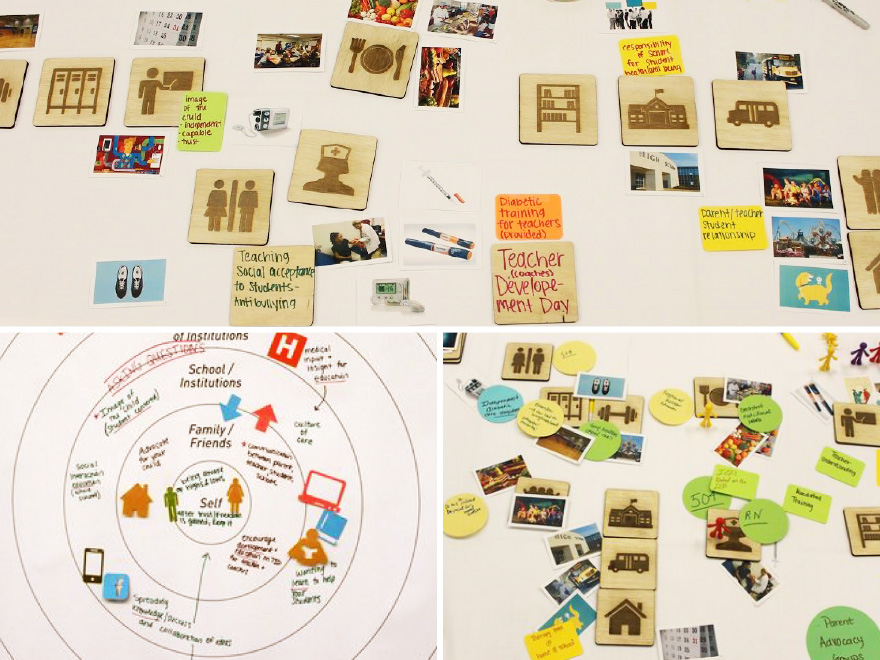
SYNTHESIS
From the generative research session with the participants, we looked at their ideas and synthesized them with the underlying principle of “fostering a culture in which the message influences the environment, and the environment supports the message.” We created a framework based on three general categories: Knowledge, Experience, and Communication. The three categories influence each other. Knowledge improves Experience and contributes to the content of Communication, Communication improves Experience and informs Knowledge, and in turns, Experience contributes to Communication and enriches Knowledge.
While the three categories feed off of each other, we started from Knowledge as a catalyst for change. One of the recurring ideas from our co-designers (or participants) is incorporating the issue of T1D into school curriculum, i.e. making classroom be relevant to the real world. One of the possible models is to integrate different disciplines into one project ( Figure 18 ), for example Math, Nutrition, and Physical Education where teachers, nurses, and coaches work together to design a project that not only covers the topic of T1D, but also include daily life scenarios so that students and teachers alike would discover experiences that they cannot obtain from textbooks.
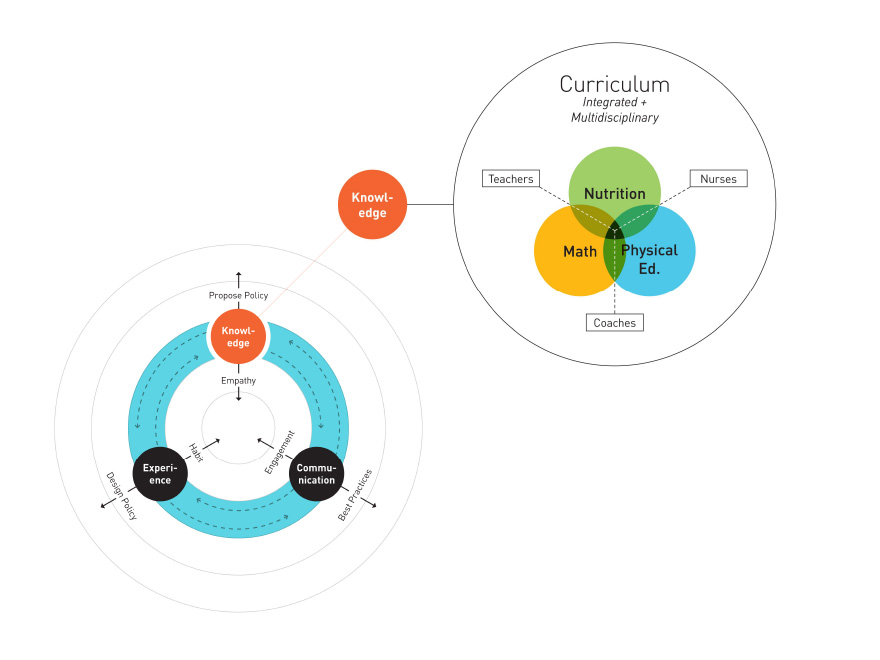
DESIGN PRINCIPLES
Finally, we wanted to create a journey map that depicts the ideal experience of a T1D student throughout a school day based on the framework we established. By mapping the envisioned journey of a future T1D student, we got a better understanding of what they might be “feeling, thinking, and doing at any given point in time when they are interacting with the school system. The journey map begins with the ‘Guiding Principles’, which is the foundation of what the future school department system could be built on.
The three principles include:
1. Foster and build a culture where the message could influence the environment and vice versa
2. Create policies to improve the educational experience of T1D’s
3. Continue to use technology as a tool to spread information and increase T1D literacy.
The three guiding principles help shape the journey of the student, as the policy, technological element, and experience help create a more informed community that is knowledgeable about many elements of T1D. With a more informed community, the data (blood glucose levels) of the T1D student is seamlessly synced between caretakers to make sure they are up to date on blood levels.
JOURNEY MAP
The success of our journey map is based on three factor:
1. All caretakers are properly T1D trained and in sync with the data provided to them
2. the student’s stress level is minimized (because of policy changes and a more knowledgeable culture)
3. Their blood glucose levels are average in order to ensure a healthy life where they are not excluded from school activities
